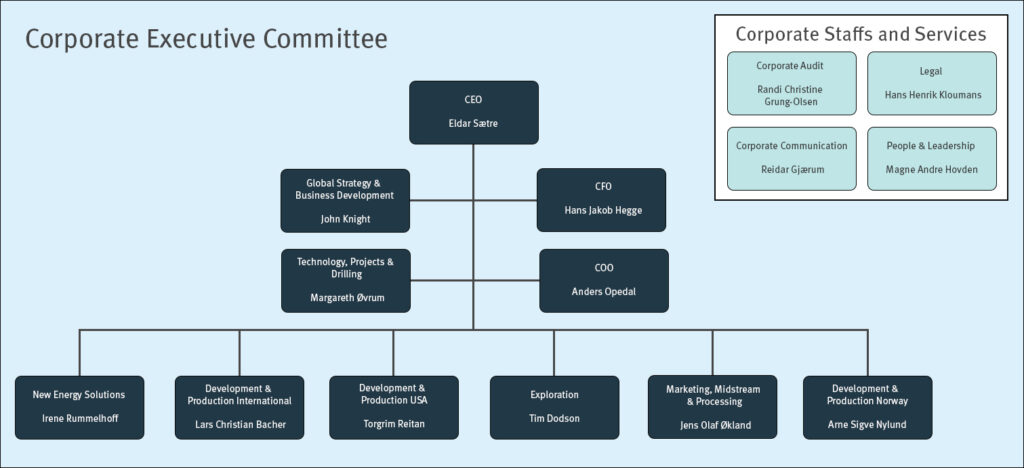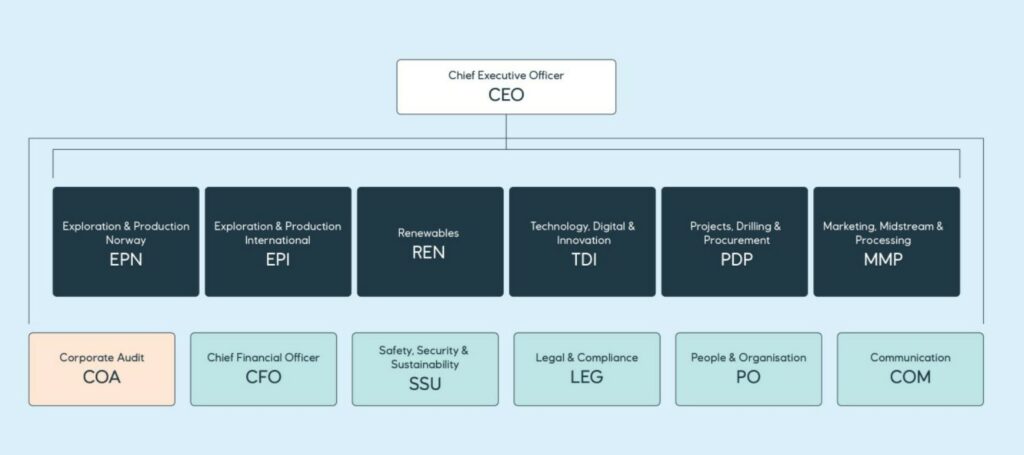Towards a broader energy enterprise – organisational aspects

Amalgamating with Hydro’s oil and energy division helped to give a clear organisational expression to a broader energy outlook in Statoil. An important reason for this was that the portfolio acquired included offshore wind power projects. A couple of years earlier, Hydro had secured a 50 per cent stake in the Sheringham Shoal development off the English east coast. The company had also been doing research on floating wind power under the name Hywind.[REMOVE]Fotnote: This would be realised in 2017 as the Hywind Scotland project.
Technology and new energy – 2007
The organisational manifestation of Statoil’s commitment to new forms of energy primarily found expression when the technology and projects business area changed its name to technology and new energy (TNE), headed by executive vice president Margareth Øvrum.[REMOVE]Fotnote: Annual report, 2007, StatoilHydro: 75. (References to annual reports in this text refer to the Norwegian edition of the reports.)
Hydro’s wind power projects were given a prominent role in the company’s description of the business area. At the same time, they supplemented Statoil’s existing commitment in such areas as carbon capture and storage (CCS).[REMOVE]Fotnote: “The new energy department is responsible for developing a sustainable business for new energy, comprising development projects and technology development such as wind power, bio fuels, hydrogen and carbon capture and storage”, annual report, 2007, StatoilHydro: 21.
Marketing, processing and renewable energy – 2011
In connection with a reorganisation of Statoil about three years after the merger, changes were made to the corporate executive committee (CEC). From 1 January 2011, the commitment to new energy was moved to the marketing, processing and renewable energy business area headed by executive vice president Eldar Sætre.[REMOVE]Fotnote: Annual report, 2010, Statoil: 7.
The latter, who was previously the company’s chief financial officer (CFO), had been a supporter of a broader energy profile for a number of years. Even so, no full-blooded commitment was yet made to this area – in part because of internal disagreements in the CEC about how large an investment budget should be allocated to renewables.[REMOVE]Fotnote: Boon, Marten, 2022, En nasjonal kjempe. Statoil og Equinor etter 2001. Universitetsforlaget: 335, 337. (Based on an interview with Sætre on 7 September 2021).

A couple of important developments from Sætre’s time as head of this business area are worth noting. First, the Sheringham Shoal project was officially inaugurated in 2012.[REMOVE]Fotnote: Sheringham Shoal (havvindpark), https://snl.no/Sheringham_Shoal_-_havvindpark, accessed 10 January 2022. Second, Hydro’s former commitments in onshore wind power were sold in order to concentrate on offshore developments. Third, Statoil strengthened its position in UK offshore wind power developments in 2012 by supplementing its involvement in the Sheringham Shoal and Dogger Bank projects – from 2005 and 2010 respectively – with participation in the Dudgeon scheme.
New energy solutions – 2015
When Sætre took over from Helge Lund as CEO in 2015, the expanded energy perspective was defined as a separate business area called new energy solutions (NES), with Irene Rummelhoff as executive vice president from June 2015.[REMOVE]Fotnote: Annual report, 2015, Statoil: 93, note 9. (References to annual reports in this text refer to the Norwegian edition of the reports.) She was succeeded by Pål Eitrheim in August 2018.[REMOVE]Fotnote: Annual report, 2019, Equinor: 119. The ambition was gradually to supplement the oil and gas portfolio with profitable renewable energy and other low-carbon solutions.[REMOVE]Fotnote: Annual report, 2016, Statoil: 18. Examples include CCS and wind power.

Renewables – 2021
After Anders Opedal became CEO in November 2020, the NES business area was renamed renewables (REN) with Eitrheim still in charge.
Just over six months after Opedal took office, the company announced plans to spend USD 23 billion on renewable energy over the coming five years. The goal was also for low-carbon solutions and renewable energy to account for more than half its gross investment by 2030.[REMOVE]Fotnote: Equinor website, Presenting strategy to accelerate Equinor’s transition, 15 June 2021, https://www.equinor.com/news/archive/20210615-cmd-2021, accessed 20 January 2022. It is also worth noting that sustainability has been explicitly raised to CEC level as part of the new safety, security and sustainability (SSU) function). It was previously part of global strategy and business development (GSB). See Equinor website, Organisation, https://www.equinor.com/about-us/organisation, accessed 29 March 2022.

Measurability and goals – from day one
This overview has covered some of the most important and visible structures in the organisation. At the same time, many patterns obviously exist which are not necessarily as explicit or easily measurable. That applies, for example, to how far a broader energy perspective has made itself felt in the organisation beyond the “technical” changes to its structure mentioned above.
However, expectations have undoubtedly increased both internally and externally that the sustainability dimension is taken explicitly into account by senior management and not least by the CEO – from day one. A sign of this is that Opedal announced on taking office that Equinor aimed to be climate neutral by 2050.[REMOVE]Fotnote: Equinor website, Equinor sets ambition to reach net-zero emissions by 2050, 2 November 2020, https://www.equinor.com/news/archive/20201102-emissions, accessed 10 January 2021.
arrow_backIntermezzo in MesopotamiaDiscovering Johan Castbergarrow_forward